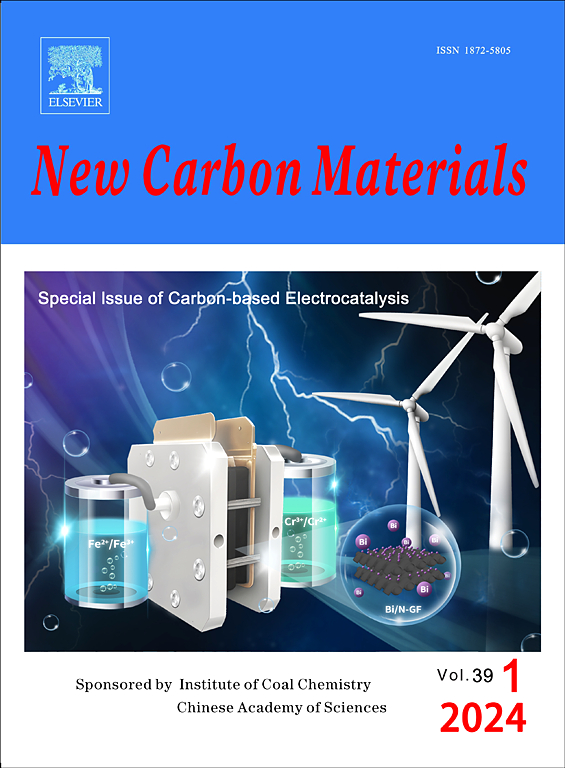The use of a ternary metal sulfide loading on carbon fibers as the sulfur host for high performance low-temperature lithium sulfur batteries
IF 5.7
3区 材料科学
Q2 Materials Science
引用次数: 0
Abstract
The use of lithium-sulfur (Li-S) batteries is limited by sulfur redox reactions involving multi-phase transformations, especially at low-temperatures. To address this issue, we report a material (FCNS@NCFs) consisting of nitrogen-doped carbon fibers loaded with a ternary metal sulfide ((Fe, Co, Ni)9S8) for use as the sulfur host in Li-S batteries. This material was prepared using transfer blot filter paper as the carbon precursor, thiourea as the source of nitrogen and sulfur, and FeCl3·6H2O, CoCl2·6H2O and NiCl2·6H2O as the metal ion sources. It was synthesized by an impregnation method followed by calcination. The nitrogen doping significantly increased the conductivity of the host, and the metal sulfides have excellent catalytic activities. Theoretical calculations, and adsorption and deposition experiments show that active sites on the surface of FCNS@NCFs selectively adsorb polysulfides, facilitate rapid adsorption and conversion, prevent cathode passivation and inhibit the polysulfide shuttling. The FCNS@NCFs used as the sulfur host has excellent electrochemical properties. Its initial discharge capacity is 1639.0 mAh g−1 at 0.2 C and room temperature, and it remains a capacity of 1255.1 mAh g−1 after 100 cycles. At −20 ~C, it has an initial discharge capacity of 1578.5 mAh g−1 at 0.2 C, with a capacity of 867.5 mAh g−1 after 100 cycles. Its excellent performance at both ambient and low temperatures suggests a new way to produce high-performance low-temperature Li-S batteries.
- Download: Download high-res image (82KB)
- Download: Download full-size image
在碳纤维上负载三元金属硫化物作为高性能低温硫锂电池的硫宿主
锂硫(Li-S)电池的使用受到硫氧化还原反应涉及多相转化的限制,特别是在低温下。为了解决这个问题,我们报告了一种材料(FCNS@NCFs),该材料由氮掺杂碳纤维组成,负载三元金属硫化物((Fe, Co, Ni)9S8),用于Li-S电池中的硫宿主。该材料以转移印迹滤纸为碳前驱体,硫脲为氮源和硫源,FeCl3·6H2O、CoCl2·6H2O和NiCl2·6H2O为金属离子源制备。采用浸渍-煅烧法制备。氮的掺杂显著提高了载体的导电性,金属硫化物具有优异的催化活性。理论计算和吸附沉积实验表明,FCNS@NCFs表面活性位点选择性吸附多硫化物,有利于快速吸附转化,防止阴极钝化,抑制多硫化物穿梭。FCNS@NCFs作为硫主体具有优异的电化学性能。在0.2℃和室温下,其初始放电容量为1639.0 mAh g−1,循环100次后,其放电容量仍为1255.1 mAh g−1。在−20℃时,0.2℃时的初始放电容量为1578.5 mAh g−1,循环100次后的放电容量为867.5 mAh g−1。它在环境和低温下的优异性能为生产高性能低温锂电池提供了一条新途径。下载:下载高清图片(82KB)下载:下载全尺寸图片
本文章由计算机程序翻译,如有差异,请以英文原文为准。
求助全文
约1分钟内获得全文
求助全文
来源期刊

New Carbon Materials
MATERIALS SCIENCE, MULTIDISCIPLINARY-
CiteScore
6.10
自引率
8.80%
发文量
3245
审稿时长
5.5 months
期刊介绍:
New Carbon Materials is a scholarly journal that publishes original research papers focusing on the physics, chemistry, and technology of organic substances that serve as precursors for creating carbonaceous solids with aromatic or tetrahedral bonding. The scope of materials covered by the journal extends from diamond and graphite to a variety of forms including chars, semicokes, mesophase substances, carbons, carbon fibers, carbynes, fullerenes, and carbon nanotubes. The journal's objective is to showcase the latest research findings and advancements in the areas of formation, structure, properties, behaviors, and technological applications of carbon materials. Additionally, the journal includes papers on the secondary production of new carbon and composite materials, such as carbon-carbon composites, derived from the aforementioned carbons. Research papers on organic substances will be considered for publication only if they have a direct relevance to the resulting carbon materials.
 求助内容:
求助内容: 应助结果提醒方式:
应助结果提醒方式:


